A Technical White Paper on Content Quality and Search Optimization
Building the Future of Programmatic Content at Scale
Executive Summary
Content quality determines success in programmatic SEO. GrackerAI's content engine produces content that meets the highest standards while scaling to thousands of pages. This white paper explains how we achieve consistent quality, maintain SEO excellence, and prepare for answer engine optimization.
Our 20-step content engine processes each piece of content through strategic planning, creation, optimization quality assurance, and distribution. Each step includes specific quality controls and automated checks. The result is content that ranks well, converts visitors, and builds authority.
Traditional content approaches fail at scale because they rely on human oversight for every piece. Our engine automates quality control while maintaining the standards that search engines and users expect. This approach lets cybersecurity companies build authoritative portals without hiring large content teams.
The Quality Foundation
Understanding Content Quality
Content quality means different things to different stakeholders. Search engines look for expertise, authority, and trustworthiness. Users want accurate, helpful information that solves their problems. Business leaders need content that drives results.
Our content engine addresses all three perspectives. Each piece goes through fact-checking to ensure accuracy. Authority comes from proper sourcing and expert voice development. Trustworthiness builds through consistent quality and transparent information.
Quality content starts with understanding the audience. Cybersecurity professionals need technical accuracy. Business leaders want clear explanations of complex concepts. Our engine adapts content complexity based on the intended reader while maintaining factual precision.
The Cost of Poor Quality
Low-quality content damages more than search rankings. It hurts brand reputation, wastes reader time, and reduces conversion rates. Poor content also creates technical debt that requires expensive fixes later.
Search engines penalize sites with thin or duplicate content. Users bounce from pages that don't meet their needs. These signals compound over time, making recovery difficult and expensive.
Our quality-first approach prevents these problems before they start. Each piece meets quality standards before publication. This proactive approach costs less than fixing problems after they occur.
The 20-Step Content Engine
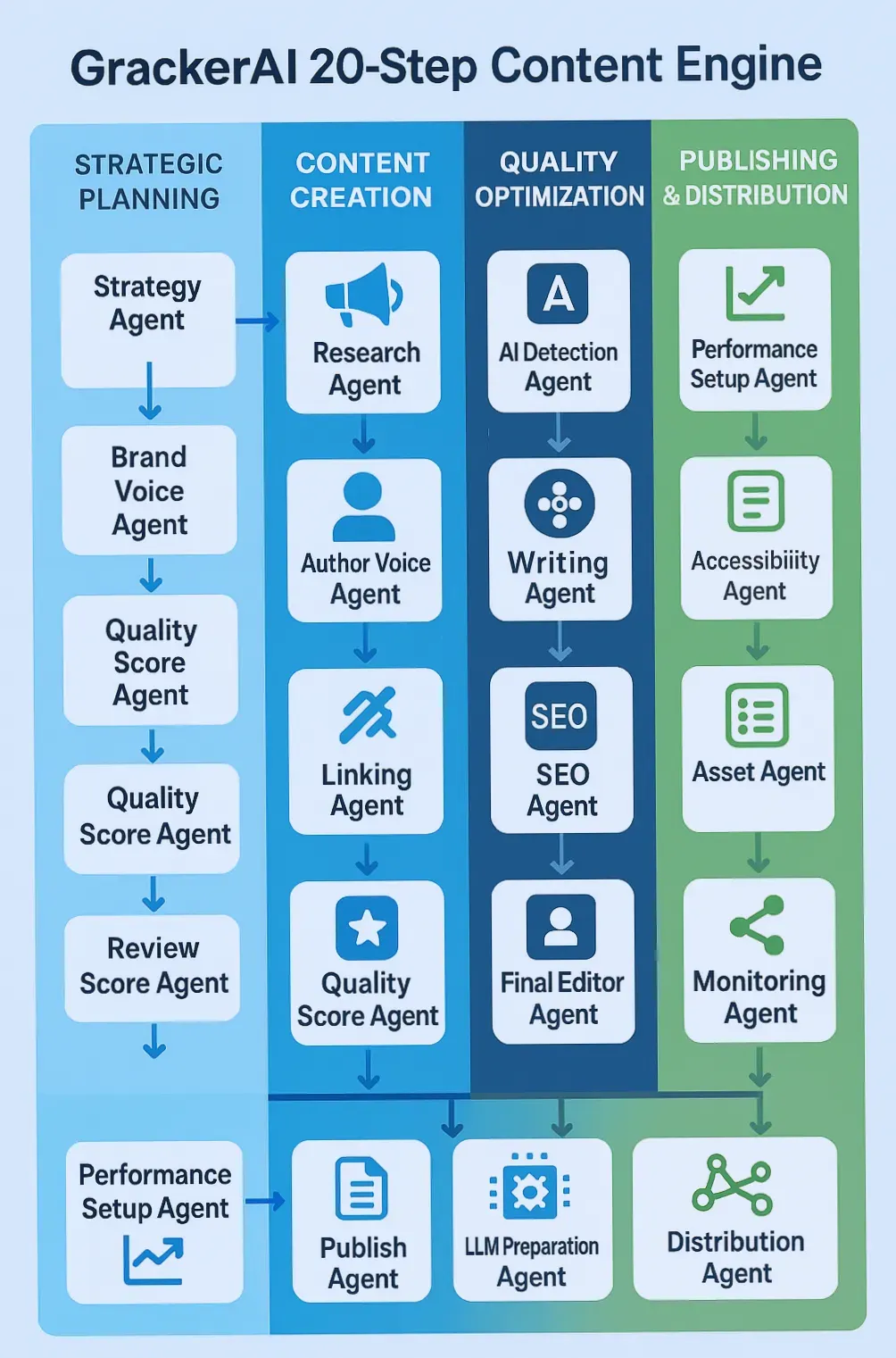
Phase 1: Strategic Planning
The foundation of quality content begins with proper planning. Our Strategy Agent aligns each piece with business objectives and content pillars. This prevents content drift and ensures every piece serves a purpose.
The Research Agent analyzes trending topics, keyword opportunities, and competitor gaps. It uses premium data sources and APIs to identify content opportunities that competitors miss. This research forms the factual foundation for everything that follows.
Fact-checking happens early in the process through our Fact-Check Agent. It verifies statistics, claims, and data sources before writing begins. This prevents the spread of misinformation and builds content authority from the start.
Phase 2: Content Creation
Brand voice consistency matters across thousands of pages. Our Brand Voice Agent establishes tone, style, and messaging guidelines for each piece. These guidelines ensure content feels cohesive even when produced at scale.
The Author Voice Agent creates expert personas for different content types. Technical content gets a different voice than executive-level pieces. This specialization helps content resonate with specific audiences while maintaining overall brand consistency.
Multiple language models power our Writing Agent. Different models excel at different content types. Technical documentation benefits from models trained on code and documentation. Marketing content uses models optimized for persuasive writing. This specialization improves output quality.
Quality scoring happens immediately after initial creation. Our Quality Score Agent evaluates content against 20+ metrics including readability, factual accuracy, and structural completeness. Content that scores below thresholds goes back for revision before moving forward.
Phase 3: Content Optimization
The Review Agent provides comprehensive feedback on structure, flow, and clarity. It identifies areas where content could be clearer or more engaging. This feedback guides revisions that improve user experience.
Strategic linking adds value for both users and search engines. Our Linking Agent identifies relevant internal and external links based on content analysis and authority scoring. It avoids over-linking while ensuring users can find related information easily.
SEO optimization happens through our dedicated SEO Agent, which runs 50+ technical checks on each piece. These checks cover everything from title optimization to schema markup implementation. The agent also ensures content follows current search engine guidelines.
Visual elements enhance content effectiveness. Our Asset Agent adds optimized images, data visualizations, social snippets, and relevant quotes. Each visual element serves a specific purpose and includes proper optimization for web performance.
Phase 4: Quality Assurance
Plagiarism detection protects against duplicate content issues. Our Plagiarism Agent scans content against premium databases and web sources. It identifies potential issues before publication and suggests revisions when needed.
AI detection tools help ensure content feels natural and human-written. Our AI Detection Agent uses multiple detection tools to identify overly robotic language patterns. Content that triggers these tools gets revised to sound more natural.
Accessibility compliance ensures content reaches all users. Our Accessibility Agent checks for WCAG compliance, proper heading structure, and readability standards. Accessible content also tends to perform better in search results.
The Final Editor Agent consolidates feedback from all previous agents. It makes final revisions based on collective findings and ensures content meets all quality standards before publication.
Phase 5: Publishing & Distribution
Performance tracking begins before publication. Our Performance Setup Agent configures analytics, UTM parameters, and conversion tracking. This preparation ensures we can measure content effectiveness from day one.
The Publish Agent handles technical deployment to content management systems. It includes metadata optimization, social media optimization, and proper URL structure. Technical details that affect performance get handled automatically.
LLM preparation creates structured versions of content for AI consumption. Our LLM Preparation Agent formats content for answer engines and AI search tools. This future-proofs content for emerging search technologies.
Distribution extends beyond the primary website. Our Distribution Agent uses IndexNow API and multi-channel syndication to maximize content reach. It also handles social media posting and email newsletter inclusion where appropriate.
Monitoring tracks initial performance and identifies issues quickly. Our Monitoring Agent watches for technical problems, user engagement metrics, and search performance indicators. Early problem detection allows for rapid fixes.
SEO Excellence Standards
Technical SEO Foundation
Technical SEO forms the foundation of search performance. Our engine checks 50+ technical factors for every piece of content. These checks ensure content meets current search engine requirements and follows best practices.
Page loading speed affects both user experience and search rankings. Our engine optimizes images, minifies code, and implements efficient caching strategies. Content loads quickly across all devices and connection speeds.
Mobile optimization receives special attention since most searches happen on mobile devices. Our engine ensures content displays properly on all screen sizes and loads quickly on mobile connections.
URL structure follows SEO best practices with descriptive, keyword-rich URLs that remain stable over time. Our engine avoids complex parameter strings and creates URLs that users can understand and remember.
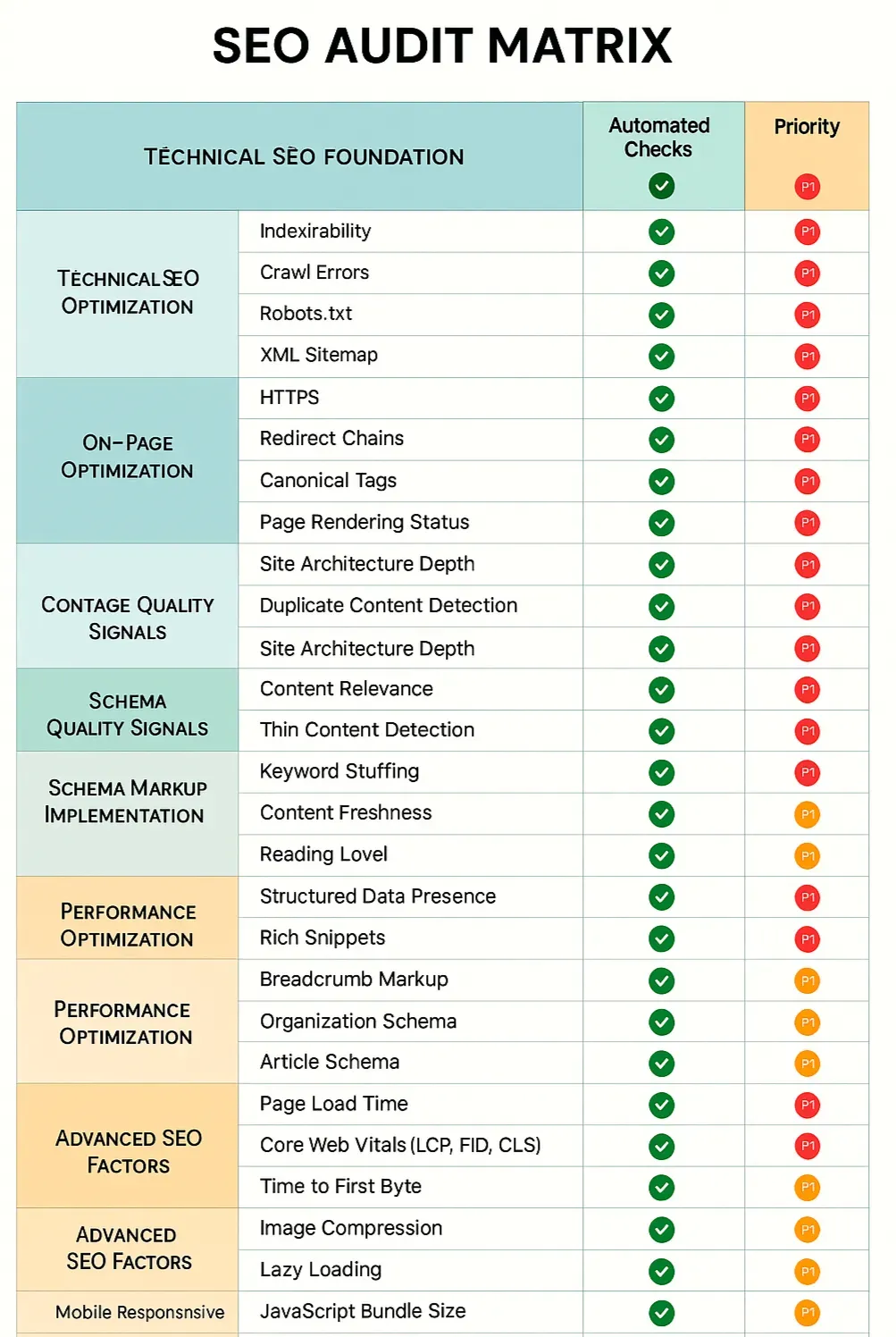
On-Page Optimization
Title tags receive careful optimization for both search engines and users. Our engine creates titles that include target keywords while remaining compelling and click-worthy. Title length stays within search engine display limits.
Meta descriptions provide clear summaries that encourage clicks from search results. Our engine writes descriptions that accurately represent content while including relevant keywords naturally. Each description stays within character limits for proper display.
Header structure follows proper hierarchy with H1, H2, and H3 tags used appropriately. Our engine ensures only one H1 tag per page and creates logical content flow through proper header usage.
Internal linking connects related content strategically. Our engine identifies opportunities to link to relevant pages while avoiding over-linking that could dilute link equity. Link anchor text provides clear context about destination pages.
Content Quality Signals
E-A-T (Expertise, Authority, Trustworthiness) guidelines influence content creation at every step. Our engine ensures content demonstrates expertise through accurate information, builds authority through proper sourcing, and maintains trustworthiness through transparency.
Content depth varies based on search intent and user needs. Our engine creates comprehensive coverage for informational queries while providing concise answers for quick lookups. Content length matches user expectations and search competition.
Freshness signals help content maintain rankings over time. Our engine updates content regularly with new information, statistics, and examples. Timestamps and update notes show search engines that content remains current.
User engagement metrics influence search rankings indirectly. Our engine optimizes content for engagement through clear structure, compelling introductions, and actionable information that keeps users on the page.
Schema Markup Implementation
Structured data helps search engines understand content context and purpose. Our engine implements appropriate schema markup for different content types including articles, how-to guides, FAQs, and product information.
Rich snippets increase click-through rates from search results. Our engine formats content to trigger rich snippets through proper schema implementation and content structure. Featured snippet optimization receives special attention for high-volume keywords.
Knowledge panel optimization helps establish entity authority. Our engine ensures consistent NAP (Name, Address, Phone) information and implements organization schema markup appropriately.
Link Building Through Value
Quality backlinks come from providing genuine value to other websites and users. Our engine creates linkable assets including original research, comprehensive guides, and useful tools that naturally attract links.
Resource page inclusion happens when content provides exceptional value on specific topics. Our engine identifies content that qualifies for resource page mentions and formats it appropriately for outreach.
Citation opportunities arise from factual, well-researched content. Our engine ensures content includes citable statistics and insights that other content creators want to reference.
Answer Engine Optimization (AEO)
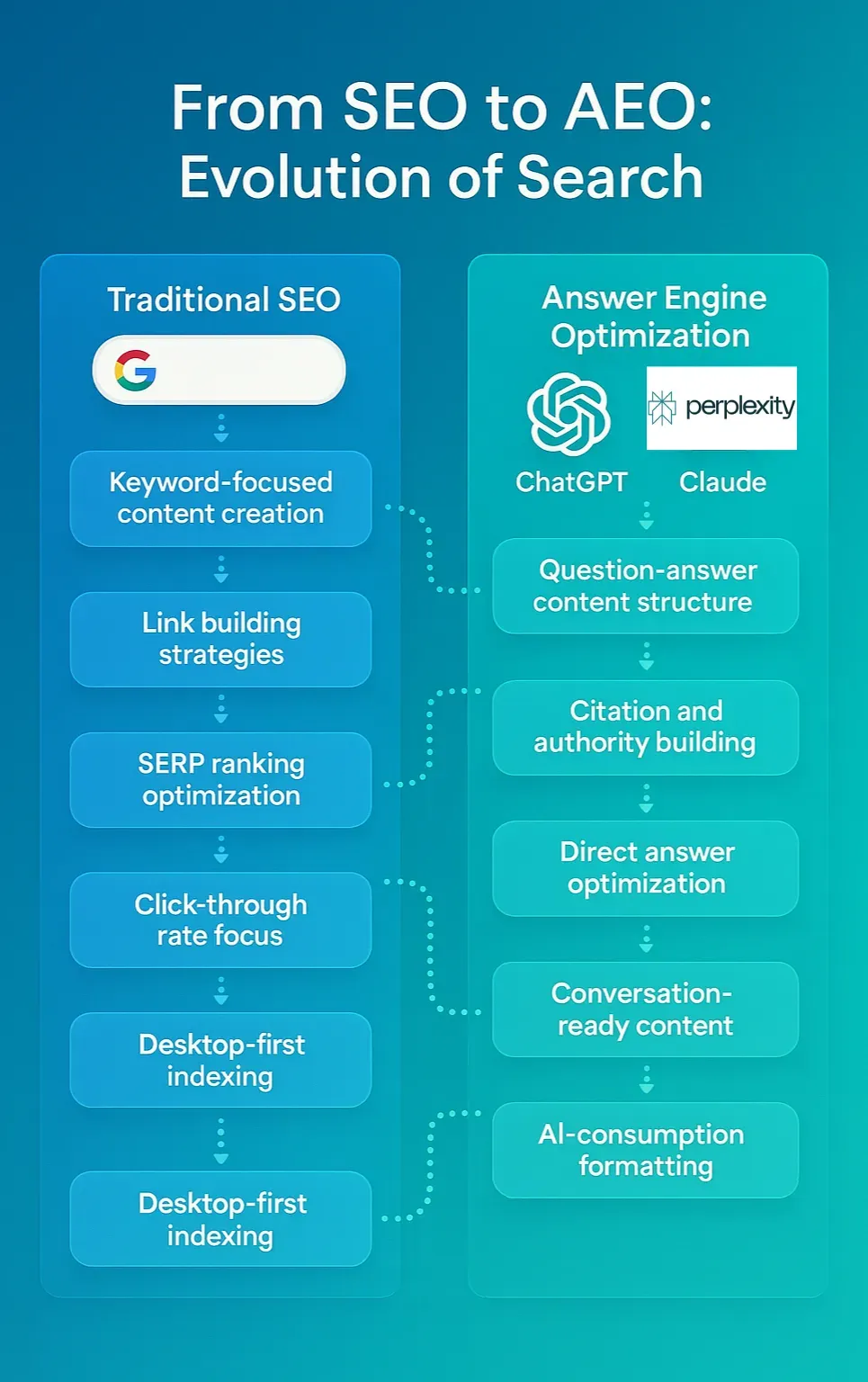
Understanding Answer Engines
Answer engines like ChatGPT, Claude, and Perplexity change how people find information. Users ask questions in natural language and expect direct, accurate answers. This shift requires new optimization approaches beyond traditional SEO.
Answer engines prioritize content that directly answers questions with factual accuracy. Our engine structures content to provide clear answers while supporting those answers with detailed explanations and evidence.
Citation patterns in answer engines favor authoritative sources with clear attribution. Our engine ensures content includes proper citations and sources that answer engines can reference when providing responses to users.
Optimizing for AI Consumption
Structured data becomes even more important for answer engines. Our engine implements schema markup that helps AI systems understand content context, relationships, and authority levels.
Question-and-answer format content performs well in answer engines. Our engine creates FAQ sections and direct question responses that answer engines can easily extract and cite.
Clear fact presentation helps answer engines identify authoritative information. Our engine formats statistics, definitions, and key facts in ways that AI systems can easily parse and cite.
Future-Proofing Content
Voice search optimization prepares content for spoken queries. Our engine optimizes for conversational keywords and natural language patterns that people use when speaking rather than typing.
Featured snippet optimization helps content appear in traditional search results and answer engine responses. Our engine formats content to answer specific questions clearly and concisely.
Multi-modal optimization prepares for answer engines that combine text, images, and other media types. Our engine ensures images include proper alt text and captions that provide context for AI systems.
Quality Control Systems
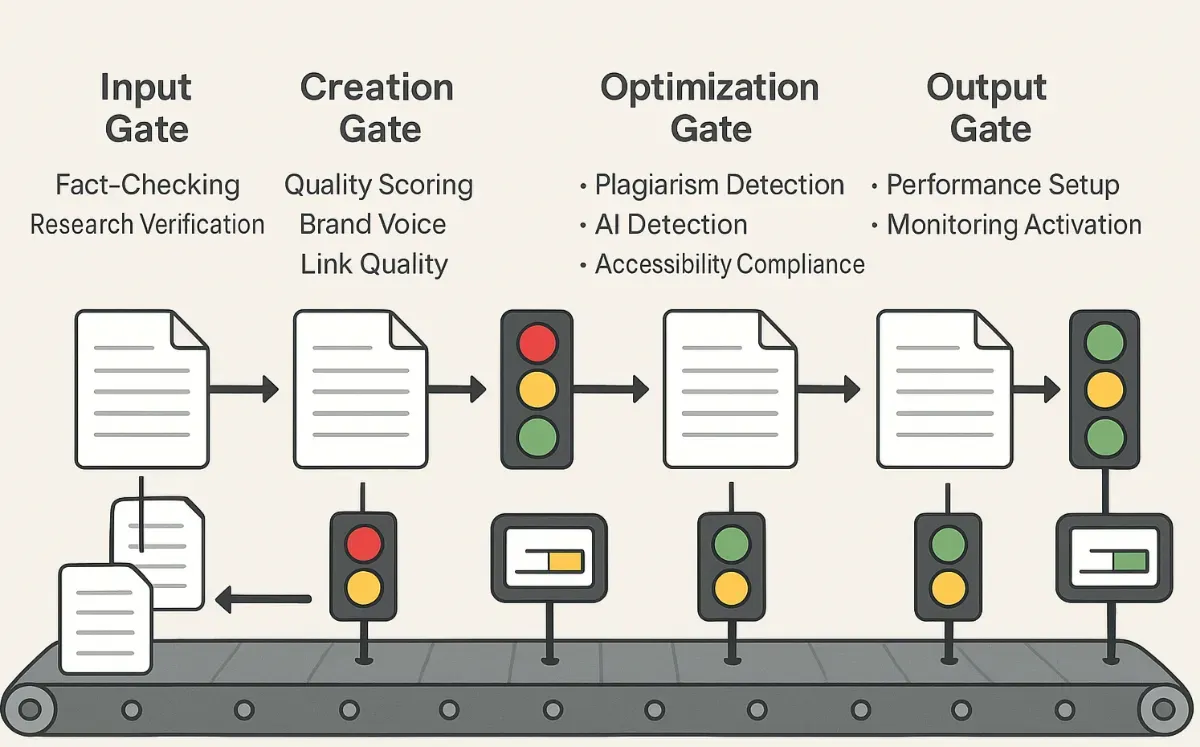
Automated Quality Checks
Our engine runs quality checks at multiple points throughout the content creation process. These checks catch issues early when they cost less to fix. Automated scoring provides objective quality metrics for every piece of content.
Readability analysis ensures content matches intended audience reading levels. Our engine adjusts vocabulary and sentence structure based on target audience sophistication while maintaining accuracy and completeness.
Fact verification happens through multiple data sources and cross-referencing. Our engine flags claims that cannot be verified and requires additional sourcing for statistical assertions.
Plagiarism detection runs against comprehensive databases including web content, academic papers, and proprietary content sources. Our engine ensures content originality while identifying areas that need additional attribution.
Human Oversight Integration
While automation handles most quality control, human oversight remains important for strategic decisions and edge cases. Our engine flags content that requires human review based on complexity, sensitivity, or quality score thresholds.
Subject matter expert review happens for highly technical content that requires specialized knowledge. Our engine identifies content that benefits from expert review and routes it appropriately.
Editorial review focuses on brand voice, messaging consistency, and strategic alignment. Our engine provides detailed reports that help human editors focus their time on high-impact improvements.
Continuous Improvement
Performance monitoring informs engine improvements over time. Our system tracks how content performs in search results, user engagement metrics, and conversion rates. This data guides algorithm refinements and process improvements.
A/B testing compares different content approaches to identify what works best. Our engine tests headlines, structures, and optimization techniques to improve future content production.
Feedback loops connect content performance back to creation processes. When content underperforms, our engine analyzes why and adjusts future content creation to avoid similar issues.
The SEO Checklist: 50+ Quality Checks
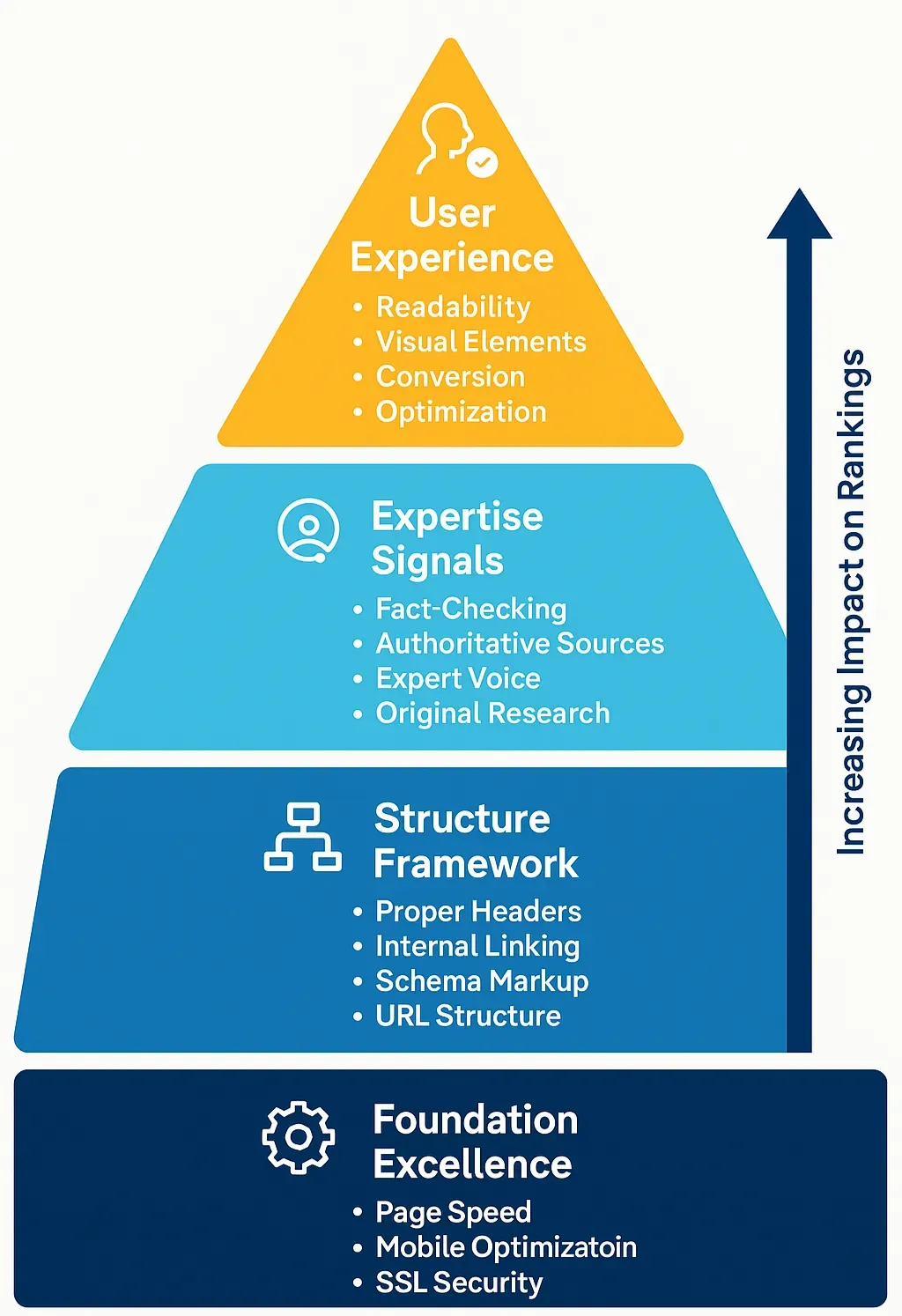
Pre-Publication Technical Audit
Before any content goes live, our engine runs comprehensive technical checks that ensure optimal search performance. These checks happen automatically but follow manual audit procedures that SEO professionals use for high-stakes content.
URL structure verification ensures clean, descriptive URLs that follow SEO best practices. Our engine checks for proper keyword inclusion, avoids dynamic parameters, and maintains consistent URL patterns across the site.
Title tag optimization balances keyword inclusion with click-worthiness. Our engine verifies title length stays within 50-60 characters, includes primary keywords naturally, and creates compelling titles that encourage clicks from search results.
Meta description creation provides accurate summaries that encourage clicks while staying within 150-160 character limits. Our engine ensures descriptions include relevant keywords without keyword stuffing and accurately represent content value.
Header tag hierarchy follows proper H1-H6 structure with logical content organization. Our engine verifies only one H1 tag per page, uses H2-H6 tags for subsections, and includes relevant keywords in headers naturally.
Content Quality Assessment
Content depth analysis ensures comprehensive coverage of target topics. Our engine evaluates content against top-ranking competitors and identifies opportunities to provide more value through additional details, examples, or perspectives.
Keyword optimization includes primary and secondary keywords naturally throughout content. Our engine checks keyword density, semantic keyword inclusion, and avoids over-optimization that could trigger penalties.
Internal linking strategy connects related content strategically without over-linking. Our engine identifies relevant internal pages, uses descriptive anchor text, and creates logical linking patterns that help users and search engines navigate content.
External linking adds credibility through authoritative sources. Our engine selects high-quality external sources, uses appropriate anchor text, and implements proper link attributes including nofollow where necessary.
Image optimization includes descriptive file names, alt text, and proper sizing for web performance. Our engine ensures images support content themes, load quickly across devices, and include appropriate schema markup.
Performance Optimization
Page loading speed optimization ensures fast loading across devices and connection types. Our engine compresses images, minifies code, and implements caching strategies that improve user experience and search rankings.
Mobile responsiveness verification ensures content displays properly on all screen sizes. Our engine tests responsive design, checks button sizes for touch interfaces, and verifies readable text without zooming.
Core Web Vitals optimization addresses Google's page experience signals. Our engine monitors Largest Contentful Paint, First Input Delay, and Cumulative Layout Shift to ensure content meets performance standards.
SSL certificate verification ensures secure connections that build user trust and meet search engine requirements. Our engine checks for proper HTTPS implementation and mixed content issues.
Schema Markup Implementation
Article schema markup helps search engines understand content context and type. Our engine implements appropriate schema for different content formats including news articles, blog posts, and how-to guides.
Organization schema establishes entity authority and provides context about content publishers. Our engine ensures consistent organization information across all content and implements proper markup for knowledge panel optimization.
FAQ schema enables rich snippets for question-and-answer content. Our engine identifies content that benefits from FAQ markup and implements structured data that triggers enhanced search results.
BreadcrumbList schema helps search engines understand site structure and navigation. Our engine implements breadcrumb markup that shows content hierarchy and improves user navigation.
Advanced SEO Factors
Featured snippet optimization formats content to answer specific questions clearly and concisely. Our engine identifies featured snippet opportunities and structures content with appropriate formatting, lists, and tables.
Local SEO optimization includes location-specific information where relevant. Our engine implements local schema markup, includes relevant geographic keywords, and optimizes content for local search intent.
Voice search optimization prepares content for conversational queries and natural language patterns. Our engine optimizes for question-based keywords and long-tail phrases that people use in voice searches.
Video and image SEO ensures multimedia content contributes to search performance. Our engine optimizes video titles and descriptions, implements video schema markup, and creates transcripts for accessibility and SEO benefits.
Competitive Analysis Integration
Competitor content analysis identifies opportunities to provide superior value through more comprehensive coverage, better organization, or unique insights. Our engine analyzes top-ranking content and identifies improvement opportunities.
Keyword gap analysis reveals opportunities to target relevant keywords that competitors miss. Our engine identifies these gaps and incorporates relevant terms naturally into content without sacrificing readability.
SERP feature analysis helps content qualify for enhanced search results including featured snippets, image packs, and knowledge panels. Our engine formats content appropriately for different SERP features.
Quality Assurance Verification
Plagiarism detection ensures content originality and proper attribution. Our engine scans content against web sources, academic databases, and proprietary content to identify potential duplication issues.
Grammar and spelling verification ensures professional presentation that builds credibility. Our engine uses advanced grammar checking that goes beyond basic spell-check to identify complex writing issues.
Readability analysis ensures content matches intended audience sophistication levels. Our engine evaluates sentence structure, vocabulary complexity, and overall reading ease to optimize for target readers.
Brand voice consistency verification ensures content aligns with established brand guidelines. Our engine checks tone, terminology, and messaging consistency across all content pieces.
Link quality verification ensures all external links point to authoritative, relevant sources. Our engine checks link destinations, verifies source credibility, and identifies potentially harmful links that could affect site authority.
Measuring Content Success
Performance Metrics
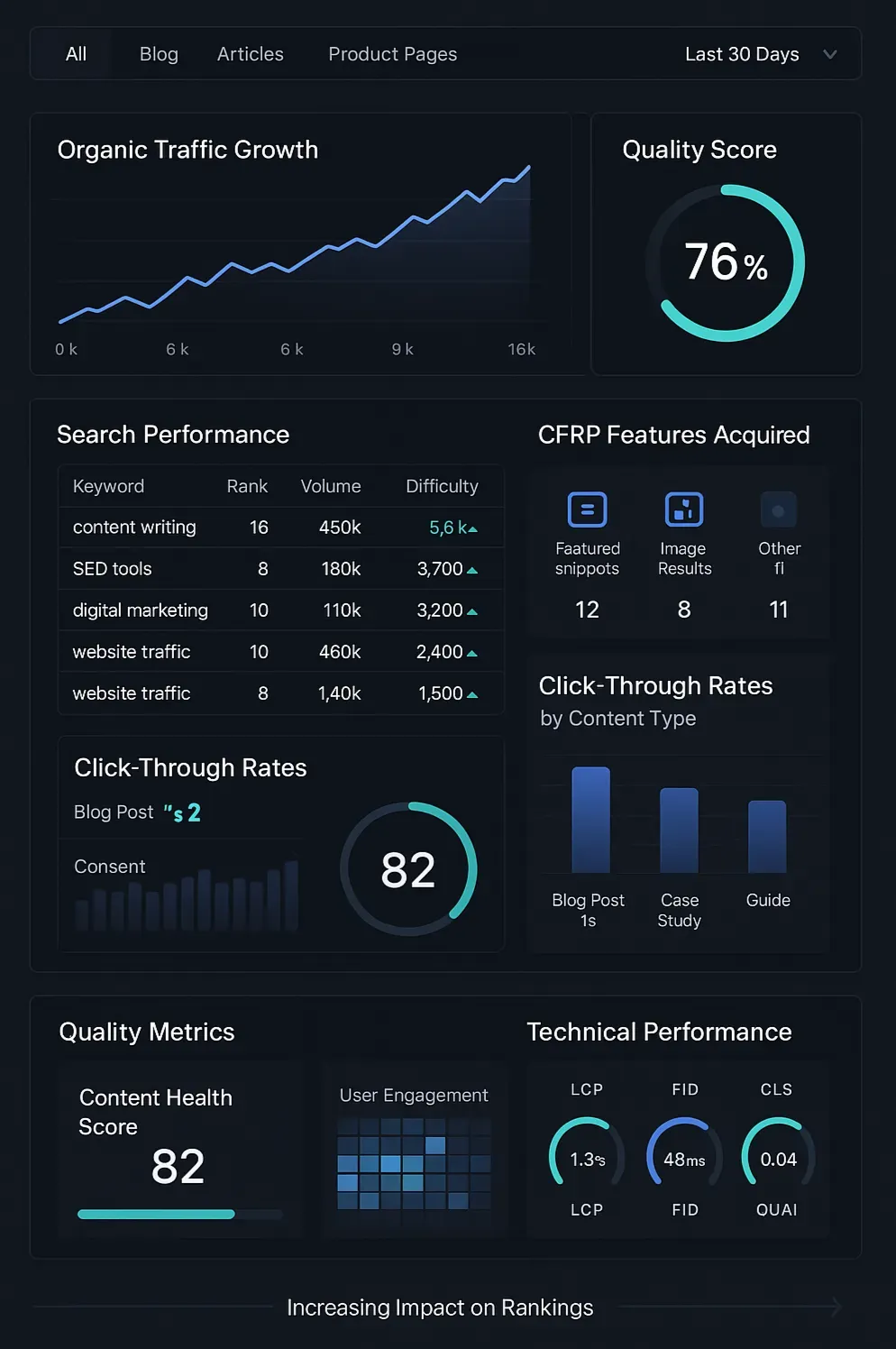
Content success requires measurement across multiple dimensions including search performance, user engagement, and business impact. Our engine tracks comprehensive metrics that provide insights into content effectiveness and guide future improvements.
Organic search traffic growth indicates content discovery and search engine confidence. Our engine monitors keyword rankings, click-through rates from search results, and overall organic traffic trends for each piece of content.
User engagement metrics reveal content quality and relevance. Our engine tracks time on page, bounce rate, scroll depth, and social sharing to understand how users interact with content and identify improvement opportunities.
Conversion tracking connects content performance to business outcomes. Our engine monitors lead generation, demo requests, and other conversion goals to measure content ROI and identify high-performing content types.
Search Performance Analysis
Keyword ranking tracking shows content performance for target search terms. Our engine monitors rankings across multiple search engines and devices to understand content visibility and identify optimization opportunities.
SERP feature acquisition tracking reveals enhanced search result appearances. Our engine monitors featured snippets, image results, and other SERP features to measure content success beyond traditional rankings.
Click-through rate analysis reveals content appeal in search results. Our engine tracks CTR from search results and identifies opportunities to improve titles and meta descriptions for better performance.
Content Quality Indicators
User satisfaction signals indicate content value and relevance. Our engine monitors metrics like return visits, content sharing, and user feedback to gauge content quality from the user perspective.
Authority building metrics track content impact on domain authority and topical expertise. Our engine monitors backlink acquisition, citation mentions, and brand search volume to measure authority growth.
Technical performance indicators ensure content meets search engine technical requirements. Our engine monitors page loading speed, mobile usability, and Core Web Vitals to maintain technical excellence.
Conclusion
Content quality determines the success of programmatic SEO initiatives. Our 20-step content engine ensures consistent quality while scaling content production to meet the demands of modern cybersecurity marketing.
The integration of traditional SEO principles with answer engine optimization prepares content for the future of search. As AI-powered search tools become more prevalent, content that answers questions directly and provides authoritative information will perform best.
Our comprehensive quality control systems catch issues before they affect performance. This proactive approach costs less than fixing problems after publication and ensures consistent user experience across thousands of content pieces.
The detailed SEO checklist ensures every piece of content meets current search engine requirements while preparing for future algorithm changes. Regular monitoring and continuous improvement keep content performance strong over time.
Success in programmatic content requires balancing automation with quality control. Our engine achieves this balance through sophisticated quality checks, strategic human oversight, and continuous performance monitoring that drives ongoing improvements.
The future belongs to companies that can produce high-quality content at scale. Our content engine provides the foundation for building authoritative content portals that generate sustained organic traffic and business growth.